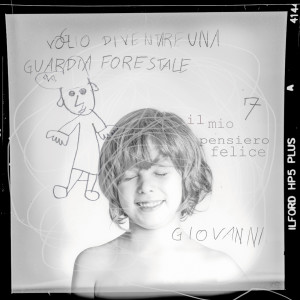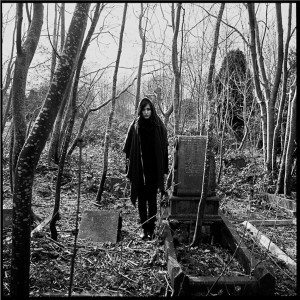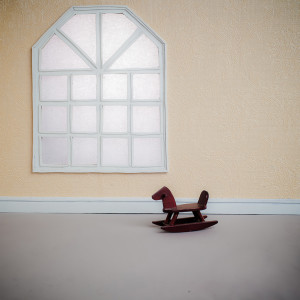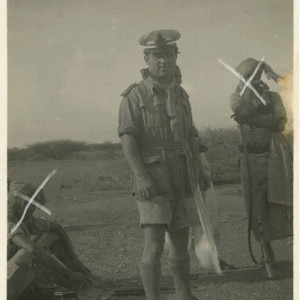Wonderful thoughts

«Dovete fare pensieri dolci e meravigliosi», spiegò loro Peter. «Saranno loro a sollevarvi in aria». E’ il Peter Pan-pensiero, la storia del bambino che non voleva crescere, nata dalla penna dello scozzese James Barrie nel 1906, che ha accompagnato generazioni e ispirato scrittori e artisti.
Ho ritratto questi bambini chiedendo loro di pensare ai loro pensieri felici e di scriverli o disegnarli. In seguito ho unito i loro disegni ai i loro ritratti. Le foto sono state scattate in pellicola e in seguito sono state rielaborate digitalmente per aggiungere i disegni.
E’ il mondo magico dei bambini visto attraverso i loro pensieri felici.
“You just think lovely wonderful thoughts,” Peter explained, “and they lift you up in the air.”
It’s Peter Pan’s thought, the story of the boy who wouldn’t grow, written by Scottish James Barrie in 1906, that has accompanied generations and inspired writers and artists.
I photographed these children, asking them to thinking about their Wonderful Thoughs, and to draw its. Then I combine their portraits and their drawings. Photos were taken with a film camera and later they were digitally edited to adding the drawings.
Here’s the children’s magic world seen through their Wonderful Thoughts.
Chanel Di Mauro maggio 25th, 2015
Posted In: PROJECTS
A tree inside me

Essere soli è una debolezza o una forza?
Nella natura possiamo vedere cose meravigliose che nella loro unicità acquisiscono il senso.
“E’ stato un mistico incontro. Per ogni foto scattata, aspettavo. Aspettavo che l’altra un’unità mi parlasse.
Restavamo a guardarci e ad ascoltarci. Io completavo la sua unità e lui la mia. E quando eravamo pronti, scattavo, e la nostra unione era resa eterna.”
Gli elementi più forti mi hanno chiamato, per eseguire loro un ritratto di maestosità.
Una pietra (Avebury, UK), un albero (Ashton Court, Bristol, UK), una tomba (Bristol’s cemetery, UK).
La disperazione della solitudine può virare in forza, se si percepisce se stessi come unità necessaria e insostituibile al proprio essere.
“Ho un albero dentro di me. Ho un mondo interiore inesplorato e lo vedrò solo quando smetterò di sentirmi solo einizierò a vedermi forte.”
Being alone is a weakness or a strength? In nature we can see wonderful things thaat acquire meaning in they uniqueness.
“That’s was a mystical meeting. I was waiting, every shoot. I was waiting for a word from the Other Unity.
We stayed watching and listening each other. I contemplated his unit and he admired mine. And when we were ready, I shot. That was our eternal union.”
The strongest elementes asked me to portrait their majesty.
A stone (Avebury, Uk), a tree (Ashton Court, Bristol, UK), a tomb (Bristol’s cemetery, UK).
The anguish due to loneliness can turn into strength, if you percepive yourself as necessary and irreplaceable unity.
“I have a tree inside me. I have an unexplored inner world and I will be able to see it only when I will stop feeling alone and I will feel powerful.”
Chanel Di Mauro maggio 25th, 2015
Posted In: PROJECTS
I was here

Ambienti vuoti, luoghi dove abbiamo abitato, vissuto e amato.
Gli spazi si impregnano delle nostre emozioni e ci parlano anche quando le persone che gli abitavano non esistono più.
Possiamo ascoltare gli oggetti e i muri delle nostre stanze vuote.
Possiamo sentire la presenza delle persone che erano lì.
“Io ero qui. Ecco dove ho lasciato le mie emozioni. Puoi sentirmi?”
Empty spaces, places where we used to live and love.
The spaces are saturated with our emotions and they speak to us even when the people who lived there did not exist any more.
We can listen to objects and walls of our empty rooms.
We can feel the presence of people who were there.
“I was here. That’s where I let my emotions. Can you hear me?”
Chanel Di Mauro maggio 25th, 2015
Posted In: PROJECTS
In memoriam

Questo è un diario emotivo.
Si racconta la storia di due fratelli, Arrigo Gregorio ed Ermete, reintrepretando in chiave cognitiva le loro testimonianze.
La perdita prematura di Arrigo Gregorio a causa di un incidente di volo, è raccontata attraverso il ritrovamento della tomba da parte del fratello minore, Ermete.
Come in un viaggio nella mente le immagini e le parole si mescolano tra loro, perdendo ordine e acquistando significato.
“In memoriam”, come citazione evocativa, rammenta le scritte epigrafiche e sottolinea il dovere di ricordare.
La fotografia di morte nasce come attestazione di presenza.
Si è ormaiperso l’uso di fotografare una persona cara post-mortem o addirittura di posare con lei dopo la sua scomparsa.
Per secoli l’uomo si è accostato alla morte con naturalezza, accettandola come sofferenza che è parte della vita. Il rifiuto odierno verso la morte ci porta a non voler pensare che esista; con lo scopo di demonizzare la nostra paura.
Non è facile parlare di morte. Ma ecco che, parlandone, l’angoscia lascia spazio alla conoscenza di se stessi.
I. CORPO MORTO
Un corpo morto è fotografabile? E’ possibile mettersi in posa con un corpo morto?
Al centro della composizione vi è uno specchio. Come un narciso si è pronti a guardarsi, segnati anche noi da una croce.
“Memento mori”, la fugacità della vita vista attraverso i nostri occhi.
Le immagini presenti sono in parte immagini di propaganda d’archivio ed in parte inedite. I cadaveri rappresentati narrano della guerra civile in Spagna e della profanazione di tombe situate sotto il pavimento delle chiese.
In alto a destra, la Vittoria Alata porta in salvo nella gloria un aviatore caduto in volo.
II. FAMIGLIA
Come affronta la famiglia la perdita di un caro sul fronte di guerra?
Nella foto di famiglia a sinistra, tutti i presenti guardano l’obiettivo, esclusi i nonni che guardano verso la parete, dove vi erano appesi i ritratti dei due figli morti in guerra. Attraverso lo sguardo essi intendevano raffigurare la famiglia al completo.
Il disegno, in alto a sinistra, rappresenta l’omino testone. Usato qui come archetipo, rappresenta il primo modo di vedere la persona cara da parte del bambino.
Sulla destra, nella foto di gruppo eseguita a Gradisca nel 1930, l’intervento artistico della negazione tramite il segno della croce vuole far riflettere sull’incognita della morte.
Sopra, due donne posano presso una tomba prima di effettuare un cambio di residenza da Alessandria a Costa di Rovigo. La volontà di farsi ritrarre vicino al sepolcro della suocera rappresenta il desiderio di connessione fisica con il proprio caro.
III. TOMBA
Un’immagine può essere vissuta tanto intensamente nella mente al punto da diventare un luogo.
La descrizione del ritrovamento della tomba di Arrigo Gregorio, da parte del fratello minore Ermete, prende forma tramite questi appunti emotivi.
This is an emotional diary.
It tells the story of two brothers during the Second World War: Arrigo Gregorio and Ermete. The premature loss of Arrigo Gregorio due to a plane crash, is told through the discovery of his tomb by his younger brother, Ermete. Like a trip into their mind, images and words are mixed together, losing order and purchasing meaning. “In Memoriam” as evocative quote, refers to the inscriptions and reminds us the duty to remember.
Death’s photography was born as certificate of presence.
We are not use to take a picture of a loved one after his death anymore. For centuries man approached death with naturalness, accepting it as pain that’s part of life. Today’s death refusal leads us thinking we are imperishable in order to demonize our fear.
It’s not easy talking about death. But, speaking about it, anxiety clears some space to self-knowledge.
I. DEAD BODY
Can a dead body be photographed? And is it possible posing with a dead body?
In the middle of the composition there is a mirror: we are also marked by a cross. “Memento mori,” life’s transience through our eyes.
The images are propaganda’s pictures and partly unpublished. The dead bodies illustrate the desecration of graves during the spanish civil war. At the top right, the Winged Victory brings a fallen pilot to the glory.
II. FAMILY
How does the family deal with the loss of a loved one in the face of death?
In the family’s picture on the left, everyone is watching into the camera, except for the grandparents who are looking toward the wall, where there were the portraits of their two sons, died in the war. Through that gaze they connect the whole family in the photograph.
In the top left corner, the drawing of a “little big head man”. Here it is used as an archetype: the first way of seeing a loved one by the child.
On the right, in the group photo taken in Gradisca in 1930, the cross’s denial aims to let thinking about the uncertainty of the death.
Above, two women are posing on the mother-in-law’s grave before moving on and changing country. Here the photograph is the physical connection with their loved one.
III. GRAVE
An experienced image can become a place.
The story of the identification of Arrigo Gregorio’s grave by the younger brother Ermete, takes shape through these emotional notes.
In the letters we perceive the sensitivity of Ermete illustrating his parents the identification of the grave and the objectivity of Arrigo Gregorio’s Superior describing death’s circumstances. At the top left corner, Ermete is posing on the grave of his brother Arrigo Gregorio.
In the center, a vertebra. Once again, an archetype: the bones as a symbol of human vulnerability.
IV. GLANCES
Planes’ images show the air raid carried out in the Spanish skies.
Above, Gorrahei’s pillbox dismantled in 1935 and Ethiopians’s bodies. In this picture the man is not really modeling. A man, is looking carefully the lifeless bodies. The gaze is alert, the body bends down to look its closely. The scene is motionless. Man and dead bodies have the same stillness. Here, the red marked white bowl is the punctum.
Daily life’s objects are the elements that lead us imagining the lives of their owners.
V. INNER BEING
The contrast between this two portraits is to study their nonverbal communication.
Through the body’s language we can find signs of truth or contradiction. On the left, the airman is posing with his faithful Dubat in 1936 in Abyssinian territory. On the right, Gino, Ermete’s friend, photographed in 1941 in Cyrenaica.
VI. THE INTIMATE ROOMS OF MEMORIES
Light installation and slide in water
All of us have happy memories, hidden in the depths of our hearts.
Thanks to them we gain the strength to face difficulties, pain and death.
You can glimpse a light in the dark: it is the memory of the loved one, strength’s true source. A small photograph of the aviator with his wife floats in the pot, hooked on a candle. The water, as life’s archetypal symbol, nurtures the happy thoughts.
There is a light at the end of the tunnel: it is the power given by the memory of loved one. A small slide of the aviator with his children is placed in the center of the bright spot of the picture.
VII. DECORATES’s DAY
Video. Duration: 01:59 minutes
The original video was shot on May 22, 1966, in Adria, on the occasion of Decorated’s Day. On that occasion a commemorative stone was placed in honor of eight aviators and the command of Milan’s First Air Region authorized the overflight of supersonic aircrafts during the ceremony.
The crosses that mark the faces are denial’s marks: an artistic and symbolic work to the purpose to let thinking about death’s unpredictability. Crossing a face can remember ourselves that one day we will have to deal with death. The rhythmic timbre you hear is the original audio of the video (super8), it recalls the noise of a machine gun.
Chanel Di Mauro maggio 25th, 2015
Posted In: PROJECTS

